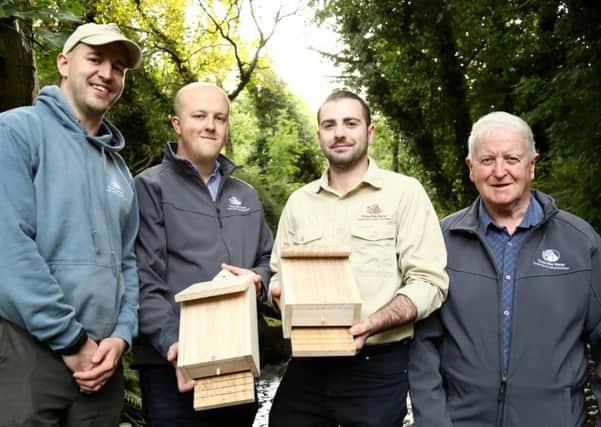Homes for Newtownabbey bats in time for Halloween


Three Mile Water River Conservation and Angling Association successfully obtained the Microgrant of almost £1,000, which will see the group being able to provide enhanced protection for, and monitoring of bats along the river, with new homes for the bats now in place.
Following a fish kill at the river in September 2015, the funding from the Community Foundation’s Microgrant programme will ensure that this Autumn gets off to a much better start for the wildlife and community surrounding the river.
Advertisement
Hide AdAdvertisement
Hide AdIt is hoped that new bat boxes will be key to retaining and attracting more of these protected mammals to the area. Their presence is welcomed along the river corridor and can be an indicator that the river itself is in good health given bats’ dependency on it as a source of food.
The Association which is celebrating its 20th year has seen the task of running the group pass this year to the next generation. It has also in the past couple of decades, become an important link between the local ecology and the surrounding Newtownabbey community; in addition to helping protect the river, the group has been instrumental in encouraging people of all ages, abilities and levels of fitness to participate in the conservation of the environment on their doorstep, by using angling as a means of promoting conservation and science.
Treasurer David Thompson said: “We work hard as a conservation group to bring not only scientific, but also social benefits to the area. We want to continue developing community led science projects that can be used for education purposes and which can also play a role in the management of the river at both local and government level.
“We have also worked hard to get the whole community involved. We have school leavers, graduates, people who are long-term unemployed and we have been able to provide not just employability skills by getting younger people involved in ecological monitoring of the river, but we have been providing opportunities for older people such as fly-tying evenings so that everyone can feel part of the club.”
Advertisement
Hide AdAdvertisement
Hide AdDavid continued: “Grants like the Community Foundation’s Microgrant give us the opportunity to be able to buy equipment above the ordinary, which further helps with the protection of the river”.
The Association has small reserves of funds but as David points out, it needs to keep this available for a proverbial rainy day.
He explained: “A fish kill is the worst case scenario. If the river were ever to be totally wiped out from source to mouth, we need to be able to re-stock it well, and for that we need to keep money on stand-by to help speed up any recovery process. The Microgrant gives us a bit of breathing space and an opportunity to bring on more volunteers.”
Congratulating the group on its funding, Andrew McCracken, Chief executive of the Community Foundation said: “Three Mile Water Conservation and Angling Association is a fantastic example of a community working together to make sure people of all ages benefit from and are actively engaged in local life.
Advertisement
Hide AdAdvertisement
Hide Ad“The group clearly has a purpose of protecting its local environment and is doing a great job, but more than that, its work shows how a community can come together over a shared purpose with people benefitting in many ways, be it reducing isolation or providing people with skills which will benefit them in future work or study.”
The Association has now been approached to share its expertise in monitoring with other groups across Northern Ireland and has developed a good working relationship with the Northern Ireland Environment Agency - not bad for a group composed of just volunteers.
As David explains, the monitoring work carried out by the Association is crucial. He added: “Our extensive monitoring of the river, including the bats means we are on the ball before water quality can become a major disaster. If mammals disappear, we want to know why. We will know that it’s either habitat or food related. If the invertebrates disappear then so will the bats and the fish who feed on them. If the fish disappear, so will the otters, herons, kingfishers and of course the anglers!
“This has a knock-on effect on the community as well. We want to not only improve the biodiversity within the river corridor and woodlands, but to encourage active participation and community pride in the surrounding area. This helps remove social exclusion and reduce isolation and depends on the input of those in the community.”
Advertisement
Hide AdAdvertisement
Hide AdIn the meantime, the community is looking forward to arrival of the bats in their new Community Foundation funded homes as a further sign of the health of the river and its associated benefits for the people of the area as well.
To find out more about the Community Foundation for Northern Ireland and its Micro Grant Programme, visit www.communityfoundationni.org or call 02890 245927.